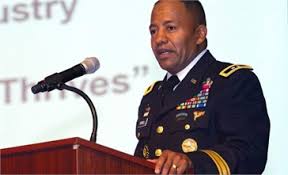
Army’s path to IT modernization buoyed by private cloud pilot
Lt. Gen. Bob Ferrell, the Army’s chief information officer/G6, said there are several parallel initiatives like data center consolidation and network...
The Army is on a different kind of mission—to close down many, if not most, of its more than 1,200 data centers located around the world.
In many ways, the Army is using a cloud pilot at Redstone Arsenal as the test case for this effort.
Lt. Gen. Bob Ferrell, the Army’s chief information officer/G6, said the Army has closed about 57 percent of its data centers since fiscal 2011 and will end up closing about 752 by the end of 2018.

Ferrell said the goal is to get down to 10 “enduring sites,” four in the continental United States—Ft. Carson, Ft. Knox, Ft. Bragg and Redstone Arsenal. The Army is finalizing the six sites that will remain around the rest of the world.
“What that will do as we start pushing the effort of closure and consolidation, it will let the units know which are the enduring sites so they aren’t guessing and they can do the early adoptions or put a time schedule on to move their apps,” Ferrell said during an interview on Ask the CIO.
Ferrell said the Army is using its cloud pilot at Redstone Arsenal to determine the best approach to constructing its data centers. The Army awarded IBM a $62 million contract in October to conduct the private cloud pilot. But it was protested by an unsuccessful bidder.
“We are very enthusiastic about the ability to move forward with the cloud technology for the Army. We see it from an efficiency and from an operational standpoint that’s the way we need to go for the Army,” Ferrell said. “Any where I can gain more efficiency from a ‘as-a-service’ than owning it, it’s a big deal for the Army because it brings the quality, partnerships and relationships on both sides of the table.”
Ferrell said the goal of the Redstone Arsenal pilot is to help the Army gain the confidence that the data located in a private cloud is both accessible whenever it’s needed and secure enough.
Army Secretary Eric Fanning will drive this point home with a new memo. Ferrell said Fanning will issue a directive and implementation plan to codify the enduring sites, establish a governance structure with tasks, schedules and timelines.
He said the goal is to give predictability and adjust the required resources, including personnel and facilities.
“Having the Secretary of the Army put out guidance saying ‘this is what he would like done by when’ is very helpful for us to get to the end state designed by OMB,” Ferrell said.
The memo and implementation plan still are going through final approvals and could be out in the coming weeks.
The data center consolidation initiative is part of a broader effort to modernize the Army’s network. In 2016, the Army modernized the infrastructure of 21 bases and plans to complete another 44 in 2017, including finishing all European bases, all Southwest Asian installations and complete at least 90 percent of the U.S. to start focusing on the Pacific region in 2018.
“We want to be done collectively by 2019. That’s the goal or earmark that was placed on us by the Secretary of Defense in the area of securing the enterprise,” Ferrell said. “We are on a good glide path.”
Ferrell said “finish” means having the Joint Regional Security Stacks (JRSS)—a single, integrated cybersecurity architecture—in place with migrations completed, all upgrades to Microsoft Windows 10 finished and significant progress with network consolidation.
“We have so many separate and disparate networks within our enterprise and so a huge initiative, all tied to synchronizing, is how do we collapse our network into getting toward the Joint Information Environment (JIE)—one enterprise, one common standards and one architecture,” he said. “We have the initiative where we are collapsing and flattening the environment onto the Army network. This year we are focused on the National Guard, the Corps of Engineers and the Reserves. Thus far in calendar year 2016, we’ve moved the Reserves behind the JRSS. We’ve got the Corps of Engineers and National Guard will be completed by the summer of next year.”
Ferrell said next on the schedule are the Army Material Command, the medical community, the test and evaluation community and finally the installation community.
“From a security aspect of having one enterprise and one platform, and from a cost and operational sense, that’s the best approach the Army has taken so far,” he said.
The final piece to the Army’s modernization puzzle is moving to unified capabilities. Ferrell said UC will be the first step to bridge between the tactical and strategic environment.
“It’s more software-defined. Right now, we are more hardware focused. Stepping toward a software-defined capability is a good thing for the Army. Unified capability is the first step,” he said.
Unified capability means integrating a host of capabilities, including voice, video, chat, instant messaging and other functions.
“We will bring that to the Army and the Army will host that service for our soldiers,” Ferrell said. “When you think about how we are operating today, it’s hardwired analog systems—those phones that are in the office. Moving toward the state of the art, bringing the unified capabilities to the Army, it will allow the Army to untether the soldier from the office. Putting that phone, his work phone number on that smartphone, so he can’t hide, no matter where he goes, we will be able to contact him. If there’s a video teleconference conference requirement, you can do that on your phone. If you need to chat or IM, you can do it all there on the phone.”
The Army released the solicitation for unified capabilities in September and the service expects to make an award in third quarter of 2017.
“It will reduce our operations and maintenance costs. It will improve our ability to collaborate from a common set of capabilities. It will also allow us to divest all of the legacy circuits, telephones and network switches that we currently have to operate and maintain,” he said. “We done the cost-benefit analysis of what we are paying for the phone systems in every office space and every installation versus what the cost would be to issuing portable phones for the soldiers, and it would be a significant decrease in cost.”
Copyright © 2025 Federal News Network. All rights reserved. This website is not intended for users located within the European Economic Area.
Jason Miller is executive editor of Federal News Network and directs news coverage on the people, policy and programs of the federal government.
Follow @jmillerWFED








